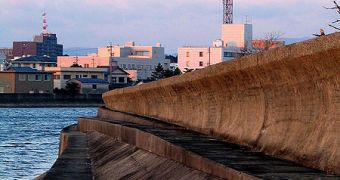Civil engineers say that the situation Japan finds itself in now can be used as a starting point for developing even more advanced defense networks, against earthquakes and tsunamis.
Even if the Asian nation is widely considered to be the most prepared in the world when it comes to dealing with the effects of such calamities, it was still heavily damaged by the magnitude 9.0 tremor that struck off its coasts on March 11.
The ground movements themselves had little effect on buildings and critical infrastructure. Japanese building codes are tremendously strict, and new edifices are required to withstand the most powerful earthquake without collapsing.
In spite of these guidelines, people were still killed. Oddly enough, they were not caught off-guard by the tremor, but by the ensuing tsunami, which grew to a maximum height of 24 feet (7.3 meters).
The wave struck the shorelines shortly after the earthquake stopped, and was able to move unimpeded through coastal areas, wiping away entire villages, settlements and small cities. Defenses to safeguard against tsunamis are on average a lot less effective in Japan than those created against tremor.
One of the factors experts identified as being responsible for this outcome is the lack of an unified standard in the design of tsunami shelters. In other words, each builders constructed the shelter how it saw fit, and not by following rules like building developers need to.
“It's not something you can do overnight, but over last 15 years practically every important building in Japan has been fitted with [tremor defense] systems. Even in some apartment buildings, they proceeded with application of this technology,” says University of Buffalo civil engineer Michael Constantinou.
That is not to say that Japan does not have tsunami defenses in place. It actually features an extensive network of them, including shelters, floodgates and seawalls such as the one in the attached image.
What the country is lacking is sufficient tsunami shelters built above the potential level the water could reach during a tsunami. Most of the existing shelters of this type consist of a large concrete slab placed on pillars.
“There are so many kinds of tsunami shelters in Japan. There is no standard design at all for evacuation buildings,” says Oregon State University (OSU) civil engineer Harry Yeh.
If inhabitants in the coastal regions of Japan most heavily hit by the tsunamis would have had the necessary shelters at their disposal then they may have survived in larger numbers.
The tsunami early-warning system that the country has announced the arrival of the massive waves about 30 minutes before they hit, so everyone may have had time to flee from their path. However, this did not happen, hence the large number of casualties, LiveScience reports.

 14 DAY TRIAL //
14 DAY TRIAL //